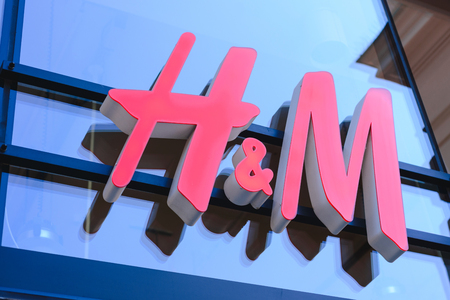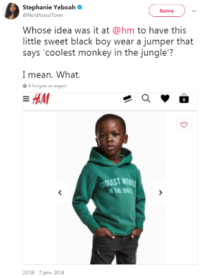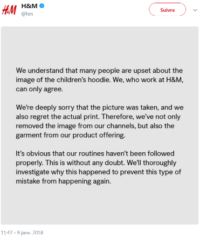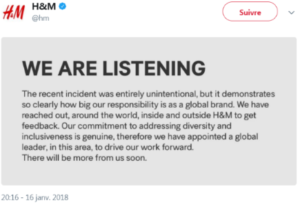
Back on a e-crisis: when H&M get into bad ways
H&M had one of its worst starts of the year. On Sunday, January 7, 2018, American blogger Stephanie Yeboah posted on her Twitter account a screenshot of the brand’s commercial site. It illustrates
a little black boy posing with a green  hoodie, with the inscription “Coolest monkey in the jungle”. Many critics then fell on the Swedish giant, accusing him of racism.The reaction of H&M was going to be late and incomplete, showing the difficulties for companies to face such questioning of their e-reputation.
hoodie, with the inscription “Coolest monkey in the jungle”. Many critics then fell on the Swedish giant, accusing him of racism.The reaction of H&M was going to be late and incomplete, showing the difficulties for companies to face such questioning of their e-reputation.
An underrated and mistreated controversy

Despite several important reactions on social networks from the first hours of the controversy (a volume of requests, concerning H&M on Twitter, increased by 350% between January 7 and 8), the multinational didn’t measure the media impact it went through and stayed silent. Its silence was a costly mistake because on the evening of Monday, January 8, the famous Canadian artist The Weeknd announced the end of his collaboration with the brand propelling the crisis to a new level of intensity on social networks. It was not until the day after this announcement that H&M reacted, in a constrained communication, when the situation was out of control.
Tuesday, January 9, more than 2 days after the first critics, H&M finally reacted via a tweet: the brand apologizes and claims to have withdrawn the product from his offer.
But beyond the question of timing, the content of the message was far from satisfying. The reaction of the brand should have been on the register of empathy with a strongly emotional character, but it was not the case. It would have been wise that the message recalls the values and the causes defended by the company. By acknowledging its wrongs and adopting a posture of repentance without committing itself to the implementation of concrete solutions to “repair” and especially to prevent such an error from recurring, H&M appeared as the passive victim of its own mistake. In addition, a few days later, a new event revived the controversy.
From a digital crisis to physical violence in stores
On January 13, the weekend after the controversy, videos circulating on the web in South Africa showed H&M salesmen abused and stores ransacked, forcing the company to close its doors.
 Then, a second media coverage relayed the subject. H&M tried to ease the situation by posting a second message on its Twitter account informing about the closure of the stores to protect customers and employees.
Then, a second media coverage relayed the subject. H&M tried to ease the situation by posting a second message on its Twitter account informing about the closure of the stores to protect customers and employees.
It’s only on Tuesday 17January, 9 days after the start of the controversy, and once the media pressure had dropped (see chart below), that H&M announced, in a third message, the implementation of a preventive action plan and the recruitment of an expert. If it had been published earlier, could it have defused the situation before the crisis?
Could it have attracted the attention of the public highly mobilized a few days ago? The initiative to open a dialogue would, at least, have had the merit of humanizing the brand and creating a horizontal relationship with stakeholders.
An e-reputation to rebuild
For H&M, the crisis was important because it is societal and ethical. It violated the values and the brand positioning of the company. In addition, it is the entire world population that was affected: this crisis had generated millions of reactions on the only Twitter social network, causing a debate, sometimes violent, on the racist nature of the image. The difficulty for the brand was to identify the timing and the register on which to react, to better preserve its reputation. After the similar crises of Dove and Zara, the case of H&M proved that brands have a real difficulty in determining the communication strategy to adopt in such situations.
For H&M, it is time now to rebuild its e-reputation that will require strong gestures and … a lot of perseverance and patience.

(Volumétrie twitter sur la requête “H&M”)
